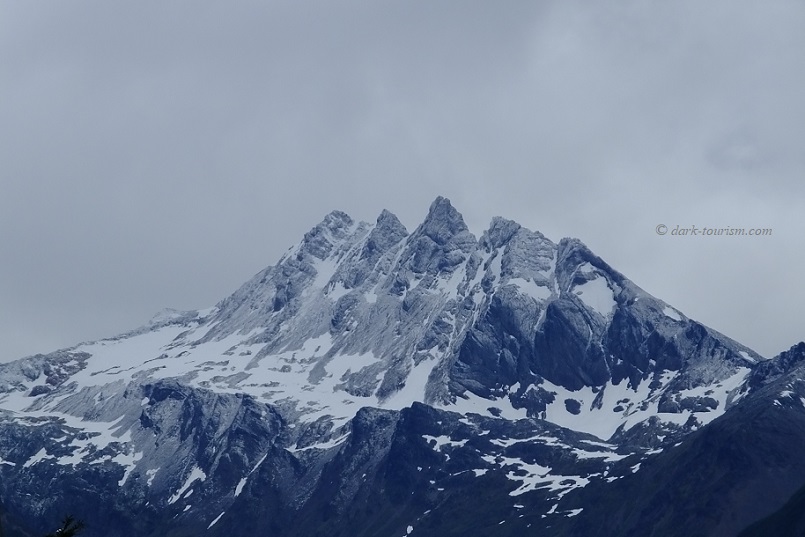Yet another post featuring a photo with glacial ice! But this time it is for a different reason than suggesting virtual cooling off. Rather it is about chilling in another, more figurative sense … read on … it is going to get very chilling!And more photos will feature as well further down.
Yesterday’s news included that Ennio Morricone had died, aged 91. He had still been very active, producing music and touring until late 2019. He was best known as a film music composer, although he also did other sorts of music, the full gamut, from avant-garde modern to pop (including a collaboration with the Pet Shop Boys!). Yet for a majority of people his name is most closely associated with so-called “Spaghetti Westerns” (i.e. made by Italians, like Morricone himself) and in particular those by director Sergio Leone. The latter’s epic masterpiece “Once Upon a Time in the West” starring Charles Bronson and Henry Fonda (as a bad guy – for the first time in his career) and released in 1968 features theme music by Morricone that the composer himself regarded as his best. It was also a revelation for me as a young boy watching the movie for the first time and through it discovering the powerful effects music can add to films. That famous harmonica theme followed by a heavy, low-pitched electric guitar tune was even picked up by British prog rockers Muse, who included a version of it in their live gigs (see e.g. the album “Live at Rome Olympic Stadium”, recorded in Morricone’s home city!).
However, here I would rather point out a different work of Morricone’s, in film but outside the Western genre, namely in horror – and that brings us into dark territory! The film I’m referring to is “The Thing” by director John Carpenter, one of the top masters of the horror genre. It was released in 1982 and initially it was commercially and also critically not much of a success (one magazine went as far as calling it the “most hated movie of all time”). This only changed later through home video distribution and led to a reappraisal of the qualities of the film, allowing it to have a lasting long-term effect and a solid cult following. I for one have always, from my first watching of the film, thought that “The Thing” stands out as one of Carpenter’s best works (and that’s the director’s own view too, as I read in an interview yesterday). I rewatched the film late last night and can confirm that it has largely stood the test of time … even though the computer screen images do seem of course very dated and simplistic by today’s standards (it was made in the early 1980s after all) and I also took note of a couple of little inaccuracies. If you want to be pernickety, you could for example point out that the transition from Antarctic summer daylight to Antarctic winter night, when it never gets light, takes place rather too quickly in the film, like it happened in a single day. That’s not how it is in reality. But never mind. The critics of the time moaned more about the film’s “nihilistic” and “anti-authoritarian” tone and that it was “cold”, lacking characterization and “camaraderie”. To me all that sounds more like these critics simply didn’t get the film. I immediately liked the film’s departure from the classic noble-hero trope, and the anti-authoritarian element in that it’s the head of the team who lacks leadership and masculine bravado and instead practically gives up. Maybe that was just too “un-American” for the time. It also happened to be released around the same time as “E.T.”, which evidently appealed more to the masses’ taste for the portrayal of aliens. Carpenter’s take is indeed infinitely darker, but I find it far preferable!
But back to Ennio Morricone. The music he wrote for “The Thing” is without any doubt one of the best works of music that I know of, a stunning and frequently absolutely chilling score using both a full orchestra and synthesizers … plus organ and piano too. I own the original recording done by Morricone on vinyl and tape cassette (released back in 1982!) – which I then digitalized myself. I even used parts of this for the music I edited for the “Gothic”-themed wedding my wife and I had largely organized ourselves in 2006. Part of my tasks was editing and compiling the music for the entire event, including the ceremony, and it was for that part that I used some bits of the music from “The Thing” to play in the background as people gathered in the vaults where the ceremony would take place.
I find this music supremely atmospheric – in a very dark sense of atmospheric. Every time I listen to it, it literally sends shivers down my spine; it is that dark. Just now I tracked down a YouTube video that also features the complete original recording (for now at least, I don’t know if for copyright reasons it’ll be taken down again at some point) – here is the link. So you can play it for yourself. It has a bit of a slow start, but give it time or forward a bit and you’ll get to the properly chilling parts.
I also noticed later that this music must have influenced me more than I was aware of at the time. That was in the mid-1980s and I was doing some compositions on the side which I realized with my synthesizers, sequencer and tape recorder at home. I was consciously taking in bits of inspiration from musical elements I encountered in my musicology studies at Hamburg University (my second subject, while English linguistics was my main subject), but consciously and not too directly. But when I now listen to the fourth set of a suite I completed back then I hear distinct similarities to the Morricone tracks “Eternity” and “Sterilization” from “The Thing”, just rolled into one piece and with extra lines added. But still, had I actually published this music, I could perhaps even have been accused of plagiarism. Yet I was totally unaware of this when I created this music. It slipped in subconsciously. “The Thing” really must have gotten under my skin, then!
But back to the movie “The Thing”. Only a small part of Morricone’s original music was used in it, as Carpenter tends to follow a rather minimalistic approach to film scores (as evidenced by the film music he’s made himself for some of his films, such as the original “Halloween” with its highly iconic, simple but effective theme tune in a 5/4 beat). You can compare the film music to the original by using this link to another YouTube video that (not quite correctly) claims to feature the “complete score”. Although I understand that the whole original would probably have been too varied and overbearing for the film, I nevertheless think this reduction was a bit unfortunate, as I’ve always thought certain bits from the original music that are missing in the film could have fitted some of the scenes really well. For instance whenever I hear the third track “Contamination” I have in my head images of the scene of the first transformation, of that dog from the Norwegian station.
For those unfamiliar with the film I probably should explain a little at this point. The science-fiction horror story, based on a novella (and much more closely than the earlier film version from 1951) is set in Antarctica, where an American research team is based. They take in a sled dog that had been chased by a Norwegian helicopter and shot at by rifles. The chopper accidentally blows up, killing the pilot and another agitated Norwegian is shot dead in self-defence by one of the Americans as the Norwegian frantically keeps trying to gun down the dog. The Americans then investigate the Norwegian station and find it ruined and charred. And within the charred ruins they discover gruesomely malformed humanoid corpses. Back at their own station the American scientists perform an autopsy and find quite regular human organs. The same night the Norwegian dog in the kennel then starts the real horror story when it metamorphoses into a shocking monster and “absorbs” the other dogs. Alarmed by the noise the Americans come to investigate and end the scene of carnage by means of a flame-thrower incinerating the “dog-Thing”. Furthermore they follow data from the Norwegians and discover the crash site of an alien spaceship partly buried in ice, apparently it had been lying there for many millennia until the Norwegians found it. They conclude that it must have brought a kind of alien life form (“The Thing”) to Earth that can absorb and imitate basically any other life form either as a seemingly perfect copy or blended into any kind of horrific monstrous form when under threat. And it’s voracious, as they soon enough find out as one after the other the research station’s staff get “infected” (i.e. taken over and then mutated into monsters that get killed). The increasingly paranoid atmosphere – where absolutely anything could happen to any of them at any point – is truly memorable. It certainly haunted me for a long time, even now. The special effects, pre-CGI (!) and hence involving costly physical models, are especially shocking. I won’t give away more details of how the plot progressed from here, though. But it will probably not surprise you if I say that the film does not exactly have a classic happy ending. Not with Carpenter!
Now, to link the stories of the music, its composer and that of the film to our theme of dark tourism it would have been perfect to use some photos and travel stories from Antarctica. But since I haven’t yet been there myself I can’t do that. But then again the film wasn’t actually shot in Antarctica. The non-studio scenes were shot in Alaska and British Columbia. Yet, since I haven’t yet been to either of those places either I draw another blank. However, I took the same method of artistic licence on board and just picked an image that could have been Antarctica. In reality, though, it was taken in Argentina, namely at the spectacular Perito Moreno glacier in Patagonia. The photo at the top, repeated below, was taken from a boat that sailed along the massive glacier’s front. I thought some of the shapes of the ice do bear a certain resemblance to some of the “Thing” monsters seen in the movie.
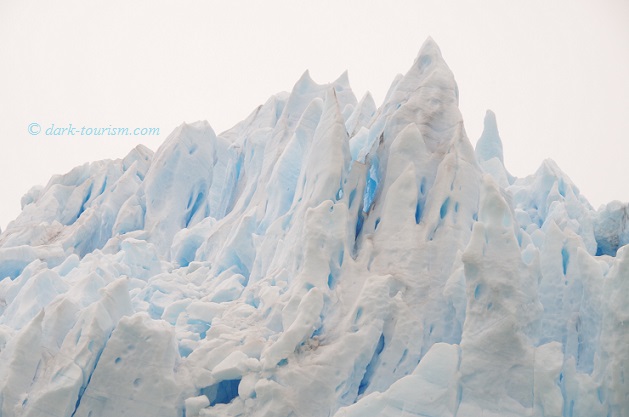
From a greater distance from the ice front you can see a kind of scenery that I could probably have passed off as Antarctica, but I resisted that temptation.
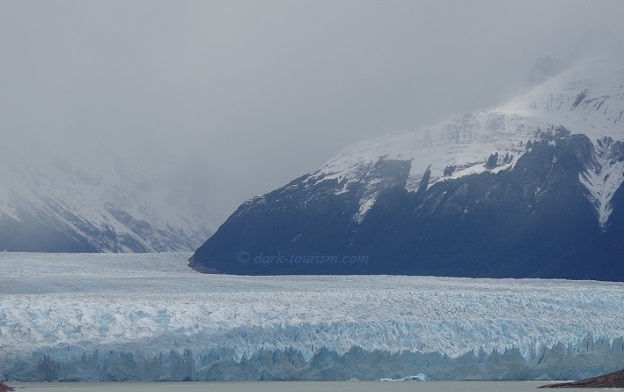
Of course I could also just have used another photo taken in the Arctic parts of Norway, especially Spitsbergen, which I had visited in the summer of 2012 … such as this one, taken from the plane on arrival just before midnight:
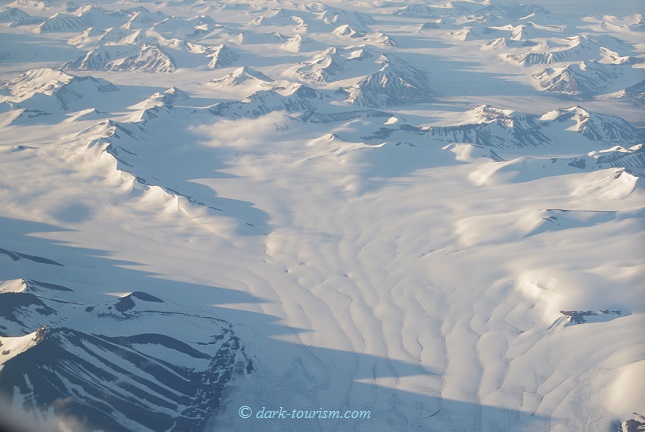
That at least had a link to Norway, if not to the Americas. The closest I have ever come to Antarctica, geographically speaking, was Ushuaia on that same trip to Argentina, Chile and the Falklands in 2013/14 on which the Perito Moreno images were also taken. Here’s one from Ushuaia looking south – from the most southerly spot I’ve ever stood on.
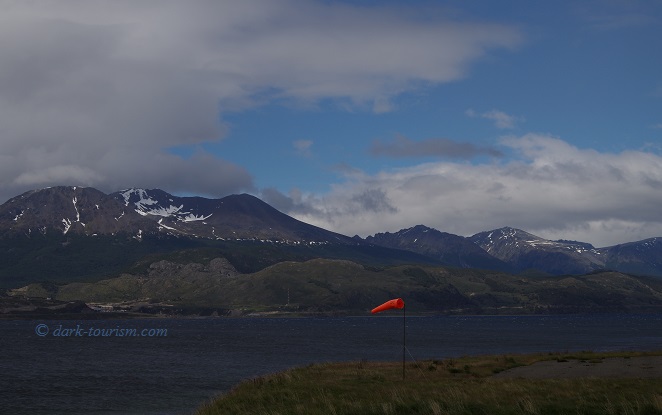
Ushuaia is in fact the southernmost city on Earth and indeed the embarkation point for a large majority of ships going on Antarctica cruises – and that’s the only form of cruise ship experience I’d ever be tempted to try (that and perhaps the one that goes from Murmansk to the North Pole in a massive Russian icebreaker). But these are very costly, especially those tours that go beyond just the tip of the Antarctic Peninsula and into the Ross Sea where you can visit the old huts of Antarctic explorers Shackleton and Scott! Unfortunately such trips are among the most expensive things you can do as a tourist and I simply haven’t got the astronomical funds required (we’re talking in excess of 30 grand – per person!).
When I was in Ushuaia I spotted various people about to join such exclusive tours and the town was also full of adverts for all sorts of such tours, including reduced last-minute offers. I couldn’t be tempted by these, though, as I wouldn’t have had the flexibility anyway, at the beginning of an already fully planned itinerary.
I had come to Ushuaia for different reasons anyway, including dark-tourism ones. The town’s top dark attraction must be the old prison, from the days when Ushuaia’s origins were owed to this forlorn place having been used as a penal colony. The prison has long been closed, though parts have been preserved in the state they were then, while others have been turned into the local maritime museum (now quite overpriced, so I have been told … I suppose it’s that moneyed Antarctica cruise ship clientele that spoils prices here). Here’s a photo from the old prison cell wing:
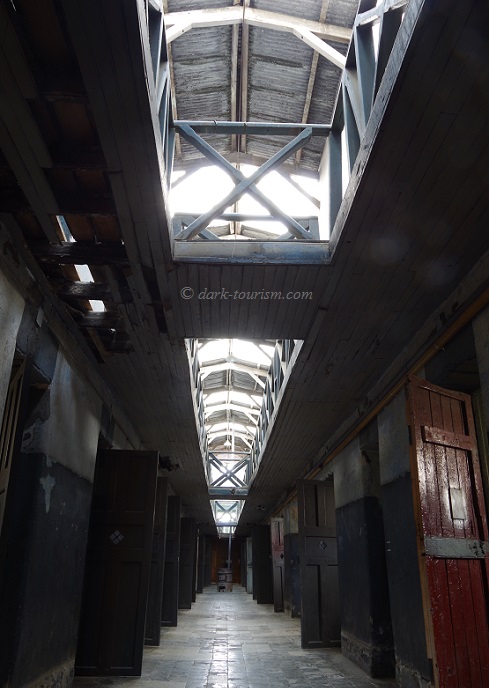
Another dark aspect about Ushuaia is that it has a link with the Falkland Islands, known as Islas Malvinas here, as in most of the Spanish-speaking parts of the Americas. In fact, had the islands become Argentinian for good (i.e. had Britain not bothered going to war over them after the Argentine invasion in 1982 and winning them back) they would have been administered from Ushuaia, under whose municipality they would have come. That fact is enthusiastically emphasized at various spots in Ushuaia, not least at this memorial complex:
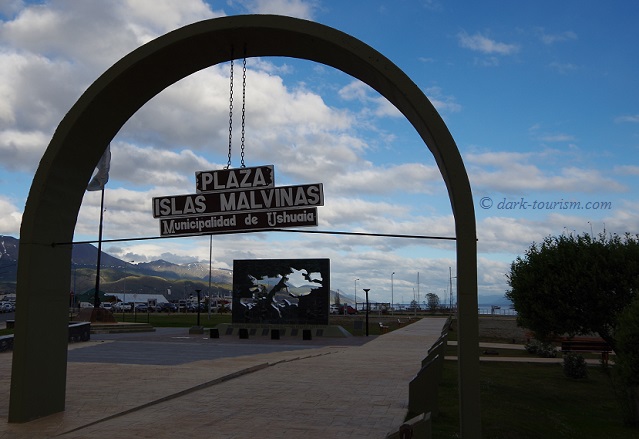
But since the Falklands remain British, you can also discover overtly anti-British propaganda in Ushuaia, such as this sign, which basically says as much as ‘English pirates not welcome”, spotted at the entrance to the harbour area.
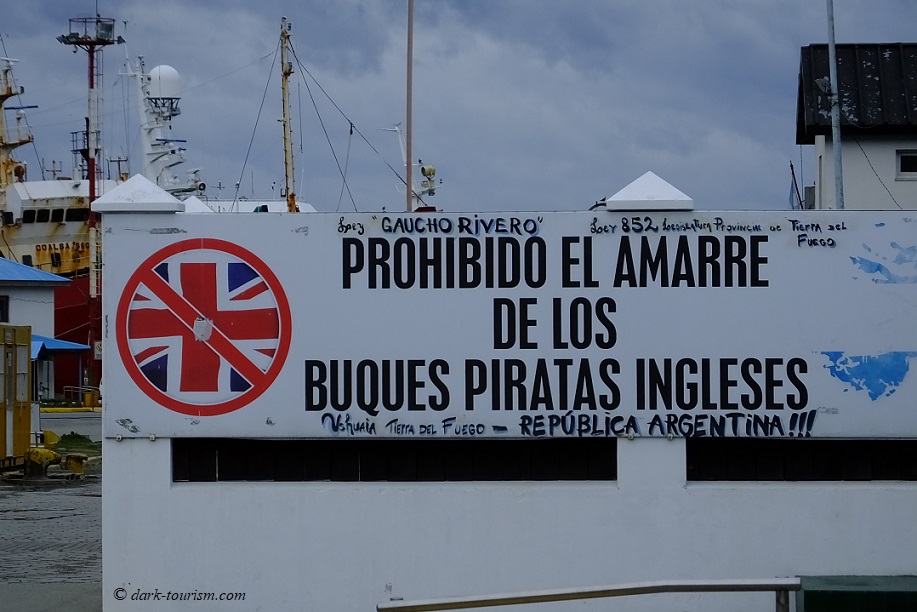
Such quietly smouldering misgivings aside, though, my wife and I found the place friendly and welcoming enough, and we had some great local food too. The views of the scenery were spectacular as well, at least for those like me who love it barren and bleak 😉 Here’s a final example – shot with zoom from near our hotel in Ushuaia, but this mountain I believe would have been on Chilean territory.
